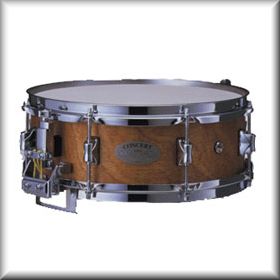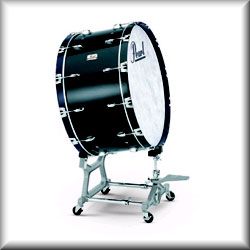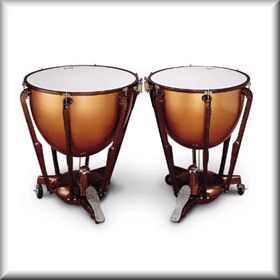Percussion instruments in a brass band, as in an orchestra or any other musical ensemble, include drums, cymbals, triangles, bells, chimes, and a variety of other things that are played principally by striking them with a stick, hand, mallet, or another instrument. The percussion section also plays the “special effects” instruments, such as slide whistles and sirens, when they are specified by a composer. The percussions section is literally the rhythm section of the band. Although their original purpose was to provide a rhythmic foundation, in modern compositions the percussion is an integral part of the overall sound of the band, having evolved far past the old “battery” of snare and bass drum.
Indefinite, Fixed, and Variable Pitch
Percussion instruments may be divided in several different ways. One key classification is the pitch of the instruments. Instruments like drums and cymbals are of indefinite pitch. The sound that they produce has no specific pitch and works with any harmony or key that the band might be playing. However, even indefinite-pitch instruments still have a relative pitch. A bass drum sounds at a lower pitch than a snare drum, even though both have indefinite pitch.
Chimes, bells, and xylophones are examples of fixed-pitch instruments. These instruments have a definite pitch, but the pitch cannot be easily tuned or changed by the player. Usually, fixed-pitch percussion instruments are arranged in sets, often in a pattern similar to a piano keyboard.
The most common variable-pitch percussion instruments are timpani, also known as kettledrums. There are two or more in a set, each one of which can be tuned to different pitches by varying the tension of the head. Modern timpani are tuned by means of a foot pedal that controls the tension. The range of adjustment is typically small, an octave or less.
Examples of Percussion Instruments
Percussion instruments come in a vast variety of shapes, sizes, and designs. The entries below give examples of the some of the more common types used in brass bands.
Drums
A drum is a hollow cylinder or tube open on one or both ends (the body) with a membrane (the head) stretched over one or both of the openings. The drum is one of the most familiar and ancient instruments and is used in almost every human culture. Drums are usually played by striking one or both heads with a stick or hand, or sometimes striking the rim or body of the drum.
Snare Drum

The snare drum, sometimes referred to as a side drum, is descended from military marching drums. The typical snare drum is relatively small, with a shallow body and two heads. The drum is played in a horizontal position, supported by a stand in a concert formation or hanging at the player’s side in a marching formation (this is the genesis of the term “side drum”). Only the upper head is struck.
The characteristic sound of the snare drum is created by the snares, which are wires tightly stretched across the lower head. When the upper head is struck, the lower head vibrates against these wires, producing a dry, rattling sound. Most snare drums are equipped with a lever that allows the player to release the tension on the snares, eliminating the rattle.
The snare drum is played with wooden sticks. Sometimes brushes are used for a softer effect. Common special effects include playing with the snares off and striking the rim instead of the head. The snare drum is of indefinite pitch.
Bass Drum

The bass drum is a large drum with two heads. It is generally played in an upright position, although many ensembles have drums mounted on special frames that allow the instrument to be rotated to a horizontal position. The bass drum is usually played with a wooden stick whose playing end is covered in felt, wool, or other soft material. One stick (sometimes double-ended) is generally used. Different effects can be obtained by striking the drum with hard sticks or timpani mallets. Either or both heads may be played. The bass drum has indefinite pitch.
Bass drums used for marching are usually smaller in size. They are carried in front of the player, resting on the chest with shoulder straps for support. A marching drummer usually uses two sticks with somewhat hard felt coverings, one for each drum head. In marching formations, the bass drum is crucial, as it is the primary means of maintaining the tempo and giving the beat for the other players.
Timpani

Timpani are large drums with a bowl-shaped body and one head. They are unique among the percussion instruments commonly used in brass bands in that they are variable-pitch. The player can tune the drum to specific pitches. In modern timpani, this is done by means of a foot pedal that changes the tension on the head. Timpani are usually used in groups of two or more, of different diameters, to give more range, as the range of possible pitches on a single drum is quite limited. They are played with a variety of mallets, varying in hardness and composition. Among the most powerful of percussion instruments, timpani can dominate the sound of the band when necessary.
Cymbals
A cymbal is a metal disc, almost flat but with a slight bell-like contour. Cymbals are generally struck with a stick or mallet. When played in pairs they are sometimes struck against each other. Modern cymbals are Turkish in origin, but the cymbal is one of the oldest known instruments. They are of indefinite pitch. Varying the size, composition and thickness of the metal, or the contour of the cymbal varies the sound, and many standard types for different effects exist.
Suspended Cymbal
The suspended cymbal is a single plate, usually placed on special stand that allows it to freely vibrate. The term “suspended” refers to a time before such stands were available, when the cymbal would be suspended from a string or wire. Suspended cymbals are played by striking the top surface with a stick or mallet.
Crash Cymbals
Crash cymbals are similar in appearance to suspended cymbals, but are always used in pairs. Each plate has a handle, usually made of leather or strong fabric. The player uses the handles to hold the cymbals, one in each hand. The crash cymbal is played by striking one with the other in a somewhat glancing blow. A fortissimo cymbal crash is powerful, and is a familiar effect.
Mallet Instruments
Mallet instruments are fixed-pitch and are played with a variety of mallets. They are made up of a collection of parts, such as bars and tubes of various materials, each part tuned to a specific pitch. These are usually arranged in a layout similar to a piano keyboard. The xylophone is the typical mallet instrument, and most other types are in a similar patter, oriented horizontally. Mallet playing can be very complex, and mallet players are considered specialists.
Xylophone
The xylophone is the prototypical mallet instrument. The instrument consists of a series of wooden bars, each tuned to a specific pitch. The bars are contained within a horizontal frame that allows them to vibrate freely (usually suspended from elastic strings). Metal tubes that resonate the sound are placed under the bars. The bars are usually arranged in a manner similar to that of the piano keyboard. Lower bars are longer and sometimes thicker than the higher bars, and the resonating tubes for the lower notes are longer. The range of the instrument depends on the number of bars used.

More advanced players can play with multiple mallets in each hand, allowing the playing of fairly complex harmony. The sound of the xylophone is relatively dry and staccato. Sustained notes are played by rolling. Tone quality is rather inflexible, although subtle differences can be achieved by varying the hardness of the mallets.
Bells
In this context, bells refers to orchestral bells. These consist of a number of metal bars, each tuned to a specific pitch, arranged in horizontal frame and laid out similar to a piano keyboard. Bells are generally played with very hard metallic or plastic mallets. They have a sustained ringing tone. The range of the instrument depends on the number of bars in the set.
Chimes (Tubular Bells)
Chimes, also called tubular bells, are long metal cylinders which are mounted vertically in a frame that allows them to vibrate freely. Each tube is tuned to a specific pitch. The percussionist strikes near the top of the tune with a hammer-like wooden mallet. The sound is similar to that of a small church bell. Most sets of chimes are equipped with a damper mechanism, often activated by a foot pedal, to control the length of the notes.
Miscellaneous Instruments
It is impossible to list all of the possible percussion instruments. The percussion section is the special effects department of the band, and almost anything that makes a sound could be considered a percussion instrument. This section mentions two of the most common.
Triangle
An instrument with indefinite pitch, the triangle is used to put high overtone highlights
on the band sound. As with most indefinite pitch instruments, larger triangles produce a deeper tone. The triangle is a metal bar, bent into a triangle with one open corner, suspended from a string or wire. It is played by striking it with a beater, usually a small metal rod. The tone is clear and high-pitched. The trill is a special technique where the beater is rapidly vibrated in one of the corners, making a sound similar to an old-fashioned telephone or alarm clock bell.
Tambourine
One of the oldest percussion instruments, the tambourine is a small drum body, with or without
a single head. Jingles, or pairs of small cymbals, are placed on spindles in slots on the body. The tambourine can be shaken or struck.
